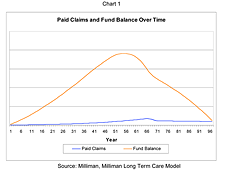A common reaction to the option of self-funding long-term care benefits is that it seems too risky. There are three important elements that drive the cost of long-term care benefits. These are the cost of the benefits, the investment earnings on the fund, and the lapse rates of employees dropping their coverage. Variation in each of these items represents risk to a self-funded plan. There are additional key elements of risk, which are the risk of adverse selection and changes in legislation or tax rules. Last month, we discussed the morbidity risk associated with long-term care benefits. This time we will focus on the remaining elements.
The second key risk is the long-term investment earnings level. This is also the most important risk that a pension fund faces. The choice of investment vehicle is very important. The average return in the post 20 years for stocks is 9.5% and for municipal bonds is 5.75%. While a prudent investment strategy will be diversified (and therefore contain a combination of investments), it would cost 60% more to invest in pure bonds compared to pure stocks. Further, if a VEBA is used, the investment return on the vast majority of the fund is taxable, further reducing the return. The risk comes with mispredicting the actual result, so a conservative assumption in developing expected costs can help protect a fund. Of course, if returns in the market are consistently lower, an insurer will also pass on the higher costs to its fully insured clients.
Another important element of a long-term care fund is the lapse rate or employee turnover rate associated with the fund. For voluntary plans, the rate is likely to be very low since the employee has decided to commit funds to the plan. Employer-paid plans (such as core plans) are likely to have much greater lapse rates. If these assumptions are set appropriately, the risk is that more people will continue the plan than expected. Since low lapse should be the assumption for the voluntary plans, the real risk occurs with the employer-paid plans, in which a higher lapse assumption would be reasonable.
Each of the risks above (and also long-term morbidity risks, discussed last month) will emerge gradually, and a self-funded plan will have time to make corrections. The advantage is that the monies are collected well in advance of the time in which benefits are typically paid out. For example, by the fifth year of the program, we would expect the money in the fund to be 50 times the amount of expected claim costs. Further, like in a pension plan, the losses (or gains) in a particular year could be amortized over the next five or more years. Thus, gains and losses might create difficult decisions about coverage in future years, but they should not affect the ability to pay in current years.

The one risk that may cause problems not solvable by use of amortization of gains and losses is the risk of adverse selection. Adverse selection occurs when individuals purchase the benefit because they are more likely to use it. This is most likely to occur among the adjunct population such as parents and retirees, or among disabled employees who meet an "actively-at-work"— standard. Adverse selection will typically cause excess claims in the early years of the fund, when adverse claim deviations are not as easily tolerated. It is critical to protect a long-term care fund with the appropriate medical underwriting.
Further, it must be recognized that the federal government likes to pass laws and issue regulations, so it is expected that the rules and taxes surrounding self-funded plans and long-term care plans could change over the years. Employers should expect to have to modify their plan from time to time because of potential changes.
Given these risks, it is very important to have clear expectations of the progression in the growth of the fund, so that any gains or losses caused by variation from these expectations can be addressed immediately. Depending on the size of the variations, actions could include changes in the funding, the employee contributions, or the benefits.
Why is true group long-term care so important?
- Many Americans will have no way to pay for long-term care services when they are needed.
- Insurance for long-term care will not become widespread if only available on an individual basis, which means that the change will need to come first from employers.
- Group coverage needs to include employer contributions to make it affordable to employees and vesting to make it affordable to employers.